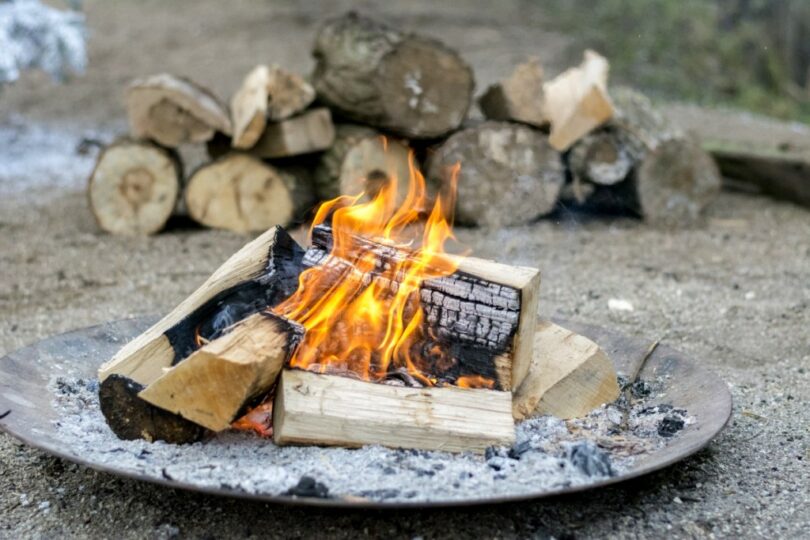What fire safety tips should you learn about before camping? People look forward the summer—the perfect time for camping, vacations and picnics. Who would not love the beautiful sunshine and wonderful wind breeze, especially when outdoors and camping?
The sun is blazing hot, a perfect opportunity for everyone to enjoy the summer with fun-filled games and family adventures that might not be possible only until next summer. And campers consider the sound of crackling coals, flickering flames and feel of warmth coming from the campfire a joy to the heart. A campfire provides not only warmth but also beauty to the surroundings, but it is also an important tool for cooking.
But during the summer season when everyone else is enjoying camping and all its sights and sounds, injuries, accidents and FIRES also can happen; in fact, around 3,800 Americans are injured by charcoal grill or gas fires, due to recreational fire and outdoor cooking.
Part of the problem is the increasing trend of using fire pits, something that has been concerning the Fire Service in the recent years because they are the main causes of campsite fires and wild forest fires. Fire pits are the top choices among families and groups holding outdoor activities, such as camping and picnics. These fire sources, although providing a great ambience and warmth, proved hazardous for campsites, especially when they go out of control and start a fire.
So if you were using a fire pit for an outdoor family activity this weekend, read on and we’ve listed the most essential tips when using them as well as tips for keeping the campsite fire-free with proper and safe use of fire pits and campfires.
What to remember when considering a fire pit
Check to see if the campground has existing fire rings or fire pits. If there’s none and pits are allowed, find a site, preferably one situated fifteen feet away from any tent walls, trees and where flammable materials are stored or located. Do not use highly flammable fluids, including alcohol, gasoline, diesel, charcoal lighter fluid and kerosene when relighting fire. Practice caution when working with an open fire, as well as do not allow children to get near it.

You should also avoid wearing flammable clothing, including that made of nylon. And then, do not burn leaves, cardboard, trash and plywood, among other flammable materials and do not use soft wood, such as cedar or pine that throws sparks and more likely to pop; use only seasoned hard wood. Before you start the fire, ensure that the pit’s lid will still close to put out the fire easily in case of emergencies and do not overload it. Finally, make sure there is a fire extinguisher or water source near the fire pit. There are techniques on how to build a smokeless fire pit. Check it our in our earlier article for more.
What to note of campfires
Campfires are some of the main causes of injuries of campers as well as of forest fires. What to remember is to practice proper burning techniques along with using safety measures to protect the forest, yourself and fellow campers. First tip is to check on the weather forecasts and fluctuations, including sudden wind gusts that could cause spark in debris, resulting in wild fires.
Ideally, the campfire should be less than four feet in diameter and three feet in height and use only untreated wood (without paint, varnish…) and only charcoal when making a campfire. Surround your campfire with rocks that do not only keep your site fire safe but they also add heat to the fire.
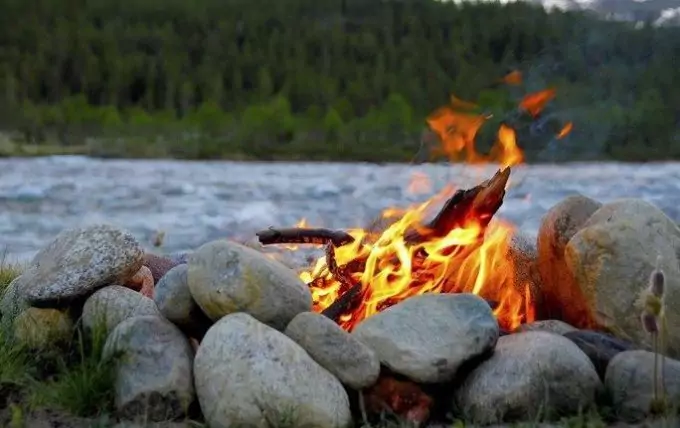
When building a campfire, make sure to do it in a place far away from overhanging tree limbs, dry grass and shrubs, automobiles and rotten stumps, among other highly flammable materials and sources. You should also take note of the fire clearance of at least three times your pile’s height because the heat usually extends far than the actual fire you can see.
Additionally, you should see to it that the burning site for the campfire is surrounded by mineral soil or gravel, which should be at least ten feet in every direction, according to sources, or you can also water down the surrounding areas before making a fire.
If you are using BQ unit, burn barrel or a small pit, make sure to put rocks underneath and around it; otherwise, fire may start underground through decaying matter and root systems.
Now when building the campfire, you should start with small sticks or dry twigs and then the largest chunks of wood, which should be pointed towards the fire center on top of them. Gradually, push them into the fire when they started burning. Do not use highly flammable materials when lighting the fire or to keep it burning and do not throw the match you used in lighting until it is cold enough to touch. Stack some extra firewood away from the fire.
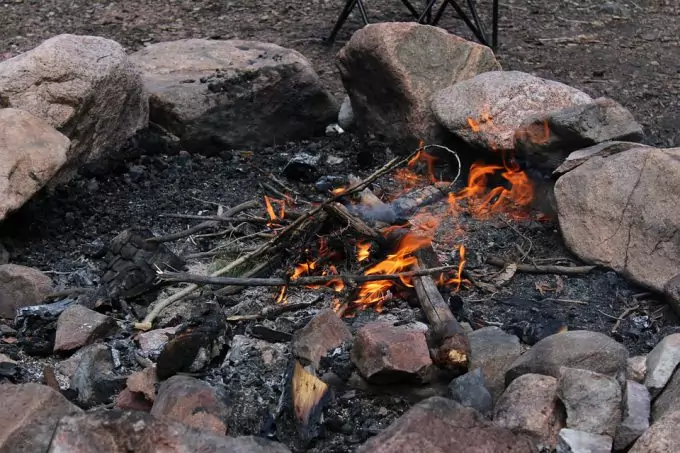
Additionally, make sure that there is water source near the campfire or have a shovel ready so that you can throw sand into the fire in case of emergency. You should not leave the fire, once burning, unattended because even small wind can spread the fire. Drown the fire with water when extinguishing it, or use dirt if you don’t find any water source. (*To use dirt, mix sand and soil and continue adding and stirring them with the fire until it is out). If using coal, do not bury them, as they can smolder to start burning again.
Extinguishing the campfire for safety
Just as building a campfire or using a fire pit, there are certain guidelines on how you should put out the fire. We’ve compiled and listed the most important ones in the following.
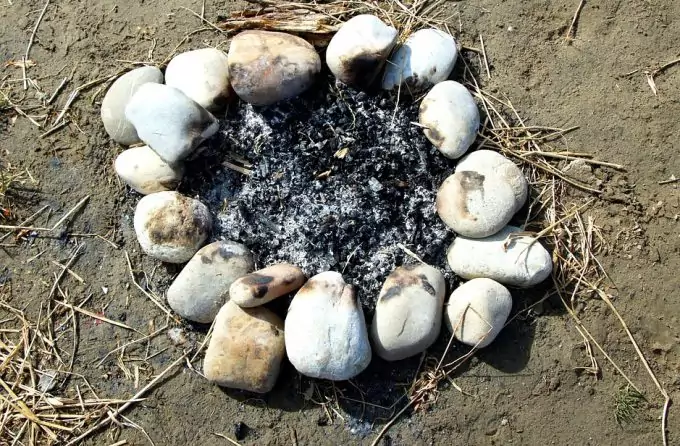
You should allow, as much as possible, to burn all the wood into ash and pour lots of water on it to make sure that the fire is totally out. Keep pouring until you don’t hear any hissing sound. You can also scrape any logs and sticks to take out any embers and stir them thoroughly to ensure that everything is wet. Finally, see to it that it is already cold to the touch before leaving it.
Keeping the campfire
When you have established strong fire, you should add larger pieces of wood to keep the fire going and burning steadily. You should ensure your children and pets do not go anywhere near it, too.
While you are enjoying the view of a successful campfire setup, you should take note that you are responsible to keeping the vicinity safe, not catching any fire. You can do it by keeping the fire to a manageable size and not leaving it unattended. Do not also cut branches and live trees to use as fuel because they don’t burn well and cutting them is not a good practice.
Additional safety tips to prevent fire in camping
Check the current rules and regulations of the campsite where you are planning to go because some of them do not allow campfires, especially during drought, and sometimes even stoves are not allowed. When needed, you should get a campfire permit.
You also should explain all safety precautions to your group, especially among children, and teach them techniques to stop, drop and roll on the ground if they catch fire.
Do not take chances in all cases, so always be prepared for the worst case scenarios when in outdoor activities and do not be careless, but think before you act and learn how to do CPR and first aid.
See also: Camping First Aid Kit: DIY First Aid Kit And Ready-Made Products
Speaking of first aid, you should take note of certain things to bring before camping, especially in terms of supplies needed for your kit. You should ensure that your kit is of great usability and so you have to know what to bring as well as how much to bring, based on several factors and individual needs. Nevertheless, your first aid kit should include,
- Adhesive tape
- Cotton swabs
- Scissors
- Personal medications
- Antiseptic wipes
- Sterile gauze pads
- Safety pins
- Tweezers
- Bee sting kit
- Bug repellent
- Sunscreen
- Sinus medications
- Tissues
- Notepad and pen
- Splinting materials
- Sterile compresses
- Blanket
- Contact person
- Small mirror
- Razor blades
- Triangular bandages
- Antibiotic cream
- Anti-acid
- Aspiring/ibuprofen
- Band Aides
- Sunburn lotion
- Ace bandages
- Snake bit kit
- Hydrogen peroxide
- Burn ointment
- Eye drops
- Cold and heat packs
- Latex gloves
- Small flashlight
- Mole skin for blisters
- First aid manuals
- Nail clippers
- Thermometer
- Poison ivy cleanser or creams
- Antibacterial soap
You should also keep yourself updated with CPR and first aid and keep your supplies in a well-marked and waterproof container. You should also keep your contents organized and know how to apply and use first aids.

*These things we’ve listed do not all have to do with fire safety, but other things you need when camping outdoors in general.
What to do when you catch fire in the campsite
When you catch fire on clothing, you should perform the following:
Stay in one place because moving or running feeds air to the fire and it can worsen the fire.
Next is to drop to the floor if you were standing up. The fire can burn your face, so in order to protect it fold your arms high on your chest.
Roll slowly on the ground, ideally on a blanket or a rug if you found one. Finally, you have to cool off with water either for first or second degree burns, but do not peel any melted clothing off your skin.
* When the area catches unmanageable fire, do not attempt putting it out yourself, but leave right away.
Tips to avoid fire in the campsite
Practice caution when using gas canisters and keep them upright all the time. You should store them in a well-ventilated area and check any leaks by putting soap around all connection. You should turn them off, too, when not in use. And when your stove is lit, do not attempt of removing or installing new propane cylinders as well as removing/installing one near a pilot light, flame or ignition sources.
Additionally, use a funnel when filling the tank and be careful to avoid the fuel from spilling. Do not store any fuel container or operate stove around another fire source, such as the campfire. You should only operate the stove in a well-ventilated, open space and not use it in a confined area, such as a tent.
Everyone must be aware of carbon monoxide when camping. One thing to do is to not take a smoldering barbeque inside a caravan or tent because the charcoal from it can emit the poisonous carbon monoxide that is colorless and odorless. Even after cooking, carbon monoxide remains in the air, so make sure that the fumes do not also build up in tents by cooking in places clear of tents and down-wind.
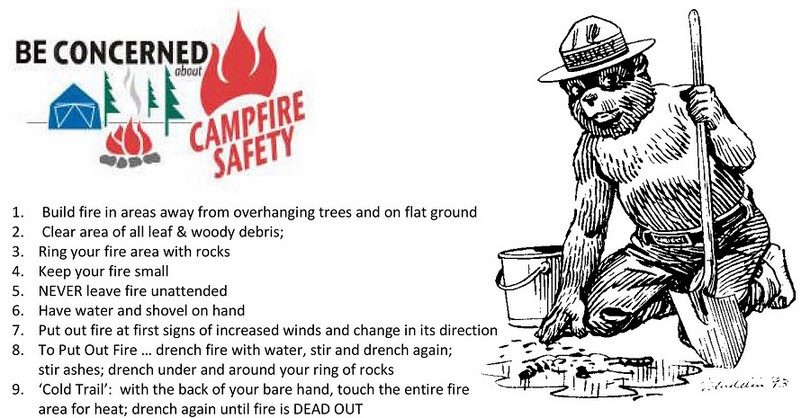
In some cases, people use mobile homes, boats and caravans when camping, and these are prone to catching fire, too, because in them are portable appliances and bottled fuels, including paraffin, petroleum gas and kerosene, which are used for cooking and heating. Do not use such products within tents or indoors.
Do your homework about the fire safety arrangements of the campsite. Do not use oil-burning appliances, such as lanterns, or candles inside the tent, but use a torch outside it instead. Do not smoke inside your tent. Set up the cooking area away from your tent and then cooking appliances in a safe place, where they won’t be knocked over. You should also keep matches, gas cylinders and flammable liquids out of children’s reach. And devise an escape plan before camping.
What to do during fire in the campsite
You should get everyone straight away because fire in tents can grow and spread fast. You should also call the Fire and Rescue Service right away and provide them with a reference map, including providing them with landmarks, such as a farm, in order for them to find you easily.
If smoking, make sure that you extinguish the fire properly and do not throw its ends on the ground or outside your caravan’s window; instead, take it home.
Do not leave bottles and glasses in the forest because they can start fire with sunlight shining through them.
Optional: Try non-match methods for building fire
First is friction-based, probably one of the hardest of all, though you can use several techniques to do it. Use a spindle (a stick) to make friction with a fireboard. When you make enough friction between the two, you can make an ember to make fire. (Fireboards can be juniper, cottonwood, aspen, cypress, willow or walnut). Make sure that the wood you use is totally dry.
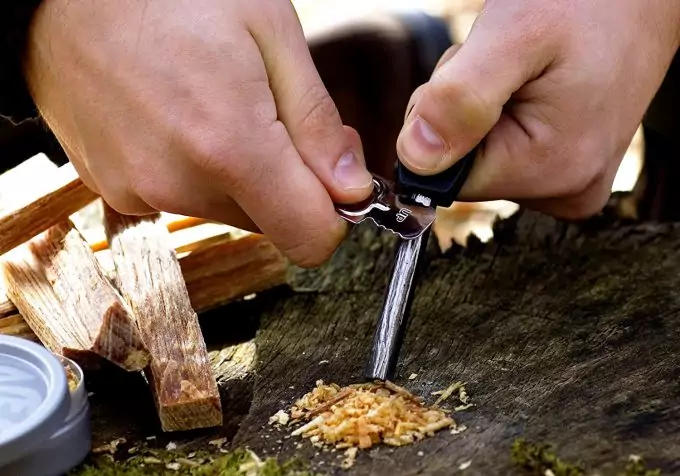
Next is the hand drill method, which is somehow one of the most primitive means of making fire without matches. What you need are your hands, wood and ‘determination.’ Make a tinder nest, what to use in making the flame you will get from the spark your hands can make. (Tinder can be anything from dry leaves and barks to dry grass, among other materials). Create a V-shaped notch into the fireboard, and then make a depression adjacent to it.
Put some tree barks, something you will need to catch an ember from friction coming from the fireboard and spindle. Start spinning before placing the spindle into the fireboard’s depression. This spindle should be about two feet long. Keep the board’s pressure and then start rolling it between hands that should be running down the spindle fast.
Continue doing it until an ember is made, and when there is fire, you can start tapping the fire board in order to drop the ember onto the bark or leaves. Transfer these to your tinder nest and then blow it gently to keep the flame burning.
Alternatively, you can use traditional lenses when creating fire. If you have a lens to focus sunlight on a specific place, then this option to make fire without matches may be for you. Get eyeglasses or a magnifying lens and add water to the lens to intensify the beam.
Then, you have to angle the glass towards direct sunlight to get the beam focused on a very small spot as much as possible. Put a tinder nest under the lens. But take note that this method only works when the sun is up.
There you have our guide to making everyone at the campsite safe through learning of the best tips to prevent fire in the campsite. If you think we’ve missed something here, feel free adding your tips in the comment section below. Finally, don’t forget sharing this article with fellow campers who might benefit from it.
Before you head out on your next trip, do read our guidelines on camping safety to protect you.


